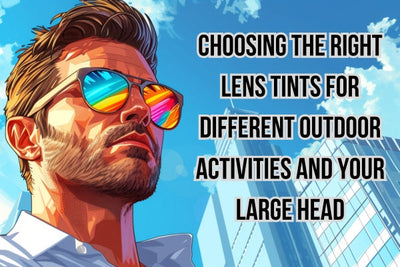By Ben Saperia | Published: June 27, 2025 | Updated: June 27, 2025
Understanding Lens Tints
Email after email used to land in my inbox from men who loved our flagship frame yet needed it in a wider size—“same look, I just need them to fit my face.” Their photos showed red lines where narrow temples pinched, that is how our sunglasses for big heads line was born. I’m 6′ 5″, so I know how ill-fitting gear distracts you all day. I sketched a 165 mm outline on scrap plywood, set a broader nose bridge, and learned that widening width alone isn’t enough; lens color must ease eye fatigue inside that extra coverage.
Here’s what each tint brings to the table:
- Gray – true-to-life colors and balanced brightness, great for everyday wear.
- Brown / Amber – heightens contrast on trails and water; my personal go-to for its “high-def” clarity.
- Green – softens glare while keeping color accuracy; trusted by drivers and golfers alike.
- Blue Mirror – reflects punishing noon sun on open water or fresh snow.
- Rose – boosts depth in flat light, handy for cyclists and skiers.
The lens makes the view comfortable; the frame makes the view possible. Put them together and long days outside feel easy on both eyes and temples.
Matching Tint to Your Outdoor Pursuit
Water & Fishing. Brown polarized lenses erase surface glare so currents, grass lines, and fish beds stand out. Our 165 mm shades for big heads wrap that tech into a broad-shouldered chassis built for big heads.
Mountain Trails. Amber or rose tints sharpen rock edges and root lines, helping you pick safe footing when the sun darts behind clouds.
Here’s the difference a blue-mirror filter makes at 8,000 feet: harsh UV drops, cloud texture stays detailed—critical for gauging afternoon weather on the descent.

Beach Days & Snow Fields. Blue mirrors bounce brutal overhead light, while a neutral gray base keeps colors honest—no more squinting at whiteouts.
Daily Driving. Green polarized lenses tame dashboard flashes without muting traffic-light hues. Choose an anti-reflective back-coating to block sneaky rear-window glare.
Dusk Dog Walks. Light-rose lenses brighten detail when the sun is low, letting you spot curbs and uneven pavement.
How We Build Big-Head-Friendly Frames
Design always starts with width. I lock the target—say 165 mm—then dial in a bridge that distributes weight evenly. Height comes last: expand it too much and you get comedy-prop eyewear; leave it unchanged and the lenses look like a skinny strip. After dozens of prototypes, we found the Goldilocks ratio that covers peripheral light yet feels intentional.
Materials matter. We mold hypoallergenic TR-90 and robust acetate blends, then pressure-test every frame on head forms up to 165 mm wide. Spring hinges free the temples to flex instead of bite. One customer wrote last week, “Three-hour road-trip, zero temple ache—I forgot I had them on.”
The photo below shows one of our prescription options, built on a 165 mm chassis. Wide geometry keeps optical centers perfectly aligned, so there’s no edge distortion—only clear, relaxed vision. You choose the lens color obviously, the option below is an unpopular choice, although some pirates love it.

Need sizing help? Our fitting-guide walks you through hat-size or circumference measurements, then recommends the right frame width—risk-free try-on for ten days.
Frequently Asked Questions
The essentials below come up in nearly every inbox thread. If yours isn’t listed, drop it in the comments so we can expand the guide.
Are polarized lenses always the best choice?
They’re unbeatable on water, snow, and bright asphalt because they block horizontal glare that forces your eyes to squint. In dim forests or thick cloud cover, however, a non-polarized amber lens can reveal more trail detail, so choose based on the light you face most.
Should I pick glass or polycarbonate lenses?
Glass delivers razor-sharp optics and resists scratches, yet it’s heavier and may shatter on impact. Polycarbonate is lighter, virtually shatter-proof, and naturally filters 100 % UV. For active use—or big frames that would feel weighty in glass—polycarbonate is the safer bet.
What tint works for all-day wear?
Neutral gray wins for versatility. It dims brightness without shifting colors, letting photographers, drivers, and beachgoers move from dawn to sunset without swapping shades.
The split image below shows an exagerated version of glare before and after an amber-polarized lens.

For a dressier vibe, check our Gentleman frame. Prefer the widest coverage we offer? Explore the entire XXL sunglasses collection—each pair meets the same impact-resistance tests our fishing pros rely on.
Thank you for supporting our small, independent workshop. If a particular tint changed the way you see the world, share your story in the comments—we read every one and often build the next design from your feedback.

